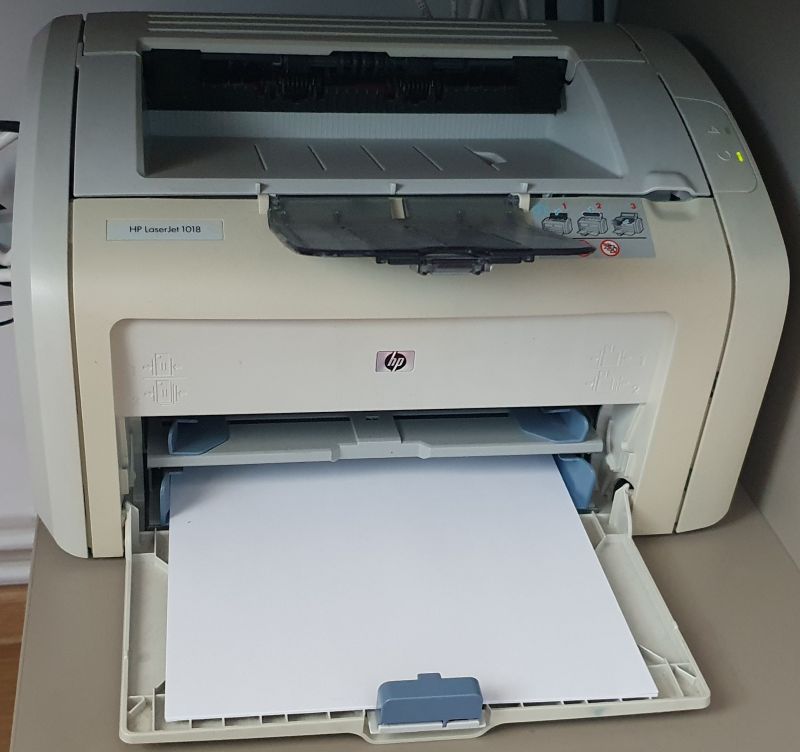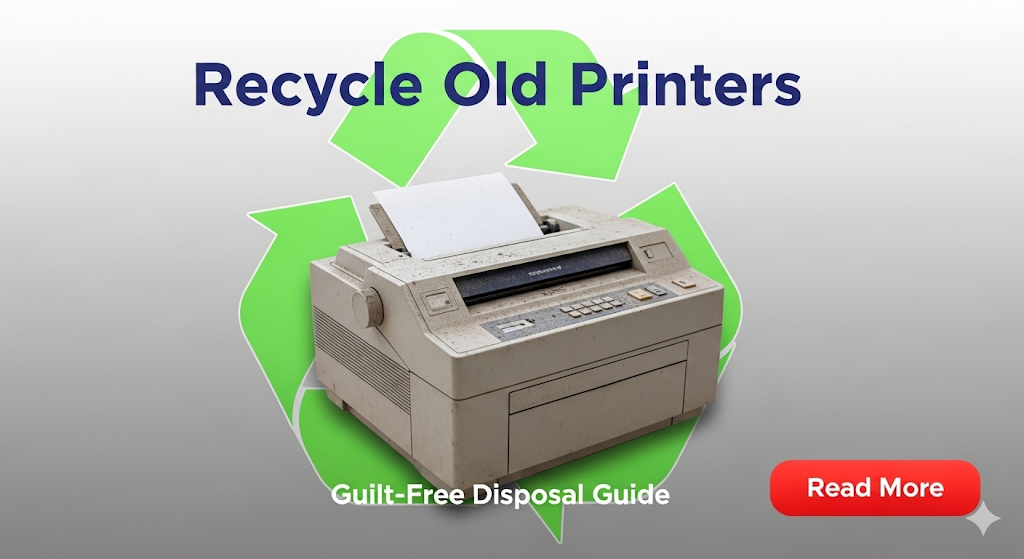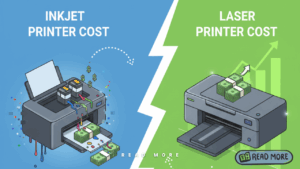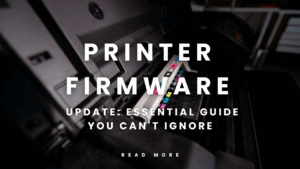Knowing how to recycle old printers and their ink cartridges is more important than ever. When your trusty machine prints its last page, the easiest option might seem to be tossing it in the nearest bin. However, these devices are a complex mix of plastic, metal, and electronic components that can be harmful to the environment if they end up in a landfill. Making the right choice is easier than you think and has a significant positive impact.
This guide provides simple, actionable steps for responsible printer and cartridge disposal. We will cover why it matters, the best methods for recycling, and specific resources available to you whether you’re in the United States, the United Kingdom, or Australia. Let’s make sure your old tech gets a new life instead of becoming a problem.
What Is E-Waste and Why Does It Matter?
“E-waste,” or electronic waste, is the term for any discarded electrical or electronic device. This includes everything from old smartphones and laptops to refrigerators and, of course, printers. E-waste is now the fastest-growing stream of residential waste in the world, and it poses a serious environmental threat.
Unlike a simple cardboard box, a printer contains a cocktail of materials. While many components are valuable, such as copper, aluminum, and gold, others are hazardous. Elements like lead, mercury, and cadmium can leach from landfills into the soil and groundwater, causing pollution and harming ecosystems.
When you choose to recycle your printer, you’re doing two great things at once. First, you are preventing these hazardous materials from contaminating the environment. Second, you are allowing the valuable materials inside to be recovered and reused in new products. This process, known as a circular economy, reduces the need for destructive mining and saves a tremendous amount of energy.
5 Responsible Ways to Recycle Old Printers and Cartridges

Disposing of your old equipment doesn’t have to be a chore. There are several convenient and free options available.
1. Manufacturer Take-Back Programs
Nearly every major printer manufacturer has a robust recycling program. They have a vested interest in sustainability and make it incredibly easy to return your old products and used cartridges. These programs are typically free.
- HP Planet Partners: HP has one of the most comprehensive programs, allowing you to mail back old printers, hardware, and ink cartridges at no cost.
- Canon’s Recycling Program: Canon offers various mail-back and drop-off options for its consumer products and cartridges.
- Epson’s RecycleRoam: Epson provides free shipping labels for you to send back old products and supplies.
- Brother: Brother has a mail-back program for its ink and toner cartridges to ensure they are properly recycled.
2. Retailer Drop-Off Programs
Many large office supply and electronics retailers offer free in-store e-waste recycling. This is often the most convenient option, as you can simply drop off your old items while you shop.
- In the US: Stores like Best Buy, Staples, and Office Depot accept a wide range of electronics, including printers and ink cartridges, regardless of where you bought them.
- In the UK: Retailers like Currys offer in-store recycling for small electronics.
- In Australia: Officeworks has a fantastic program called “Bring it Back,” accepting printers, computers, and cartridges at their stores.
3. Local Municipal Recycling Centers
Your local government or council is a great resource for e-waste disposal. Many have dedicated facilities or host special collection days for electronics. Search online for “[Your City/Council Name] + e-waste recycling” to find the nearest drop-off point and its hours of operation.

4. Donate If It Still Works
The most sustainable form of recycling is reuse! If your printer is still in good working condition but you’ve simply upgraded, consider donating it. Local schools, charities, community centers, and non-profit organizations are often in need of office equipment. A quick phone call can give your old printer a valuable second life.
5. Certified E-Waste Recyclers
If you have a large amount of equipment or want to ensure the highest standard of recycling, look for a certified e-waste recycler. In the US, certifications like R2 (Responsible Recycling) and e-Stewards guarantee that the recycler adheres to strict environmental and data security standards, and that no hazardous waste is illegally exported.
Country-Specific Recycling Guides: US, UK & Australia
Navigating recycling can vary by location. Here are some country-specific resources to help you.
- United States (US): The Environmental Protection Agency (EPA) provides resources on electronics donation and recycling. For finding local options, websites like Earth911 and Call2Recycle have searchable databases. The most convenient options for most people are the nationwide programs offered by retailers like Best Buy and Staples.
- United Kingdom (UK): The UK operates under the WEEE (Waste Electrical and Electronic Equipment) directive. Look for a symbol of a crossed-out wheelie bin on your device, which indicates it should not be thrown in general waste. The “Recycle Your Electricals” campaign has an excellent postcode locator to find your nearest drop-off point. Every retailer must also provide a way for you to recycle your old item when you buy a new one.
- Australia (AU): Australia’s National Television and Computer Recycling Scheme (NTCRS) provides households and small businesses with free access to e-waste recycling. The best tool for finding a local drop-off point is Planet Ark’s “Recycling Near You” website. Key participants in the scheme include major retailers like Officeworks, Harvey Norman, and The Good Guys, making it easy to find a convenient location.

Preparing Your Printer for Recycling: Common Mistakes to Avoid
Before you hand over your old printer, there are a few crucial steps to take. Avoiding these common mistakes protects your privacy and makes the recycling process more efficient.
- Mistake 1: Not Wiping Your Personal Data. This is the most critical step. Many modern printers have internal memory that can store a history of scanned, copied, or printed documents. To protect your sensitive information, you must perform a factory reset. This function is usually found in the “Settings” or “Tools” menu on the printer’s display. The process for a factory reset is managed by the printer’s internal software. To ensure your device is secure, it helps to understand what printer firmware is and why you need to update it.
- Mistake 2: Leaving Ink Cartridges Inside. Always remove the ink or toner cartridges before recycling the printer. Cartridges are recycled through a separate process. Many programs that accept printers also accept cartridges, but they need to be separated first.
- Mistake 3: Illegal Dumping or Binning. Never put a printer or cartridge in your household trash or recycling bin. It is illegal in many places and is guaranteed to cause environmental harm. This act, known as fly-tipping in the UK, can come with heavy fines.
- Mistake 4: Using Uncertified Recyclers. Be wary of informal “recyclers” who may not be certified. Some uncertified operations cut corners by exporting e-waste to developing countries where it is processed in unsafe conditions, harming both people and the planet.
Frequently Asked Questions (FAQs)
1. Can I get paid to recycle my old ink cartridges? Yes! Some companies and websites, especially for toner cartridges, will pay you for empty, un-refilled cartridges from original manufacturers (like HP, Canon, etc.). It’s a great way to earn a little cash back while doing the right thing.
2. My printer is broken. Can I still donate it? No. Charities and schools need equipment that is ready to use. If your printer is broken, it is e-waste and should be taken to a recycler, not a donation center.
3. Is it safe to recycle my printer? What about my data? It is completely safe as long as you perform a factory reset before you drop it off. This will wipe the printer’s memory of any stored documents and personal settings, protecting your privacy.
4. Why can’t I put my printer in the big recycling bin with plastic bottles? Printers are complex electronic devices, not simple plastic containers. They contain a mix of metals, plastics, glass, and hazardous chemicals that must be carefully dismantled and processed at a specialized e-waste facility.
Conclusion
To recycle old printers and ink cartridges is a small act with a big impact. It conserves natural resources, prevents pollution, and supports a circular economy. With so many free and convenient options available—from manufacturer mail-back programs and retailer drop-offs to local recycling centers—there is no reason for any printer to end up in a landfill.
Before you let go of your old device, remember to perform a factory reset to protect your data and remove the ink cartridges for separate recycling. Every printer and cartridge you divert from the waste stream is a victory for the planet. By following these steps, you can upgrade your technology with a clear conscience, knowing you’ve handled your e-waste the right way.
Printer Warranty Check: Your Effortless Guide to Total Peace of Mind Read More.




